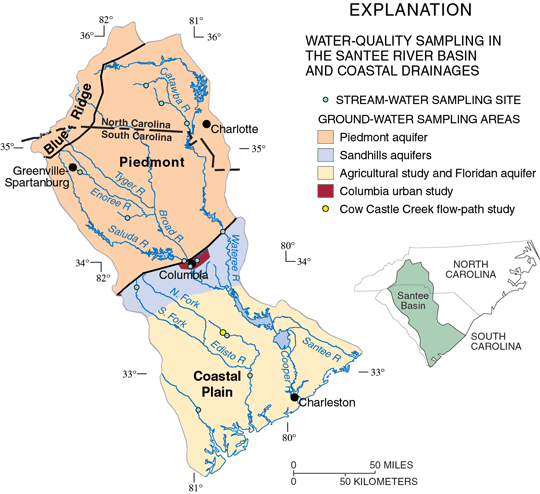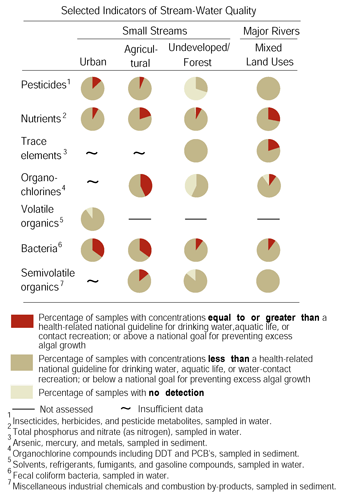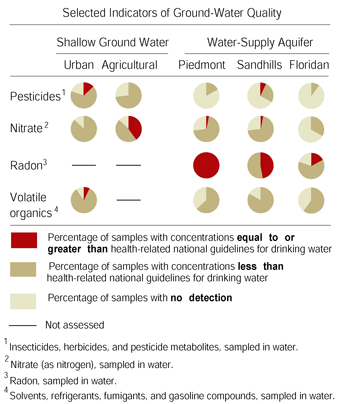SUMMARY OF MAJOR FINDINGS
Surface water sampled in the Santee River Basin and coastal drainages generally meets existing Federal and State guidelines for drinking-water quality and protection of aquatic life. However, urban and agricultural land uses have affected water quality, as indicated by elevated concentrations of bacteria, pesticides, and nutrients in basins dominated by these land uses.
 |
| The Santee River Basin and coastal drainages (the "Santee Basin") is an approximately 24,000-square-mile area in North and South Carolina that encompasses the Blue Ridge Mountains, the Piedmont, and the Coastal Plain (Fenneman, 1946). Most of the 3.5 million people in the Santee Basin live in urban areas. Eighty-six percent of the water used in homes and for industry is treated surface water withdrawn from rivers of reservoirs. Ground water is the main water source for rural households. |
- The herbicides atrazine, simazine, and tebuthiuron were detected in almost every stream in the Santee Basin, including those in forested areas, at levels below aquatic-life and drinking-water guidelines. Four insecticides—malathion, diazinon, chlorpyrifos, and parathion—exceeded aquatic-life guidelines. No pesticides exceeded drinking-water standards, though 7 of the 30 compounds detected do not have drinking-water standards and 13 do not have aquatic guidelines. Pesticide concentrations had seasonal patterns, with the highest concentrations measured in the spring following application.
- Nitrate concentrations did not exceed drinking-water standards in any streams sampled. Average total phosphorus concentrations in four streams were above the U.S. Environmental Protection Agency (USEPA) recommended goal to prevent nuisance aquatic growth. The South Fork Catawba River had an average total phosphorus concentration that was four times higher than the USEPA goal and is a significant source of phosphorus to downstream lakes. Wastewater discharge and agricultural runoff are major sources of nitrogen and phosphorus.
- Trace metals were detected frequently in bed sediment and tissue, mostly at concentrations within aquatic-life guidelines. Arsenic, chromium, and lead exceeded guidelines in a few samples. Although concentrations were not high in sediment samples, data suggest that mercury is accumulating in fish and clams in concentrations that are harmful to humans or animals that eat them. Sampling by State agencies has resulted in fish-consumption advisories for mercury in 49 rivers and reservoirs in South Carolina.
-
Organochlorine pesticides were detected frequently in bed sediment and tissue. Most of these compounds have been discontinued for use for many years but continue to be detected because they are persistent in the environment. A derivative of DDT was detected at concentrations exceeding aquatic-life standards in sediment at three agricultural sites.
- Volatile organic compounds (VOCs) known to occur in the aquifer adjacent to Gills Creek, an urban stream in Columbia, S.C., were frequently detected in the creek as well. Although no existing Federal or State drinking-water standards or aquatic guidelines were exceeded, this finding is consistent with the important influence of ground-water quality on stream-water quality.
- Bacteria levels frequently exceeded South Carolina standards for contact recreation in streams in forested, urban, and agricultural areas. Standards were exceeded more frequently in small streams than in large rivers.
- Biological communities in urban and agricultural streams had fewer species of fish and invertebrates that can tolerate contamination than forested and mixed land-use streams. This suggests that contaminants resulting from these land uses affect the natural communities that live in these areas, although factors such as habitat alteration can cause similar changes in biological communities.
Ground water in the Santee Basin generally meets existing Federal and State standards for drinking water except with respect to nitrate, which failed to meet the drinking-water standard in almost one-half of the shallow monitoring wells sampled in agricultural areas, and radon, which did not meet proposed standards in about one-half the drinking-water wells sampled basinwide. Pesticides were detected frequently in urban, agricultural, and drinking-water supply wells, but only two samples exceeded drinking-water standards. Many wells contained low concentrations of numerous synthetic chemicals related to industry, household use, and motor vehicles, and a few of these chemicals were at levels above drinking-water standards.
- Pesticides were detected in 17 of 90 wells sampled in drinking-water supply aquifers. Of the 34 detected, only 2 pesticides exceeded drinking-water standards, but 11 of the detected pesticides do not have standards. Most wells in agricultural and urban areas contained at least one pesticide, but only two wells in urban areas had concentrations that exceeded drinking-water standards.
- Nitrate is the only nutrient that was detected in significant concentrations in ground water, and it exceeded drinking-water standards in almost one-half of the shallow monitoring wells in agricultural areas. Although this finding indicates significant contamination of shallow ground water, most drinking-water wells are located in deeper aquifers. Nitrate in the Piedmont and Sandhills aquifers was elevated above natural concentrations but exceeded standards in only two wells. The Floridan aquifer, which is protected for the most part by confining units in the study area, had relatively low concentrations of nitrate.
-
Radon, a naturally occurring radioactive gas, was detected in almost all wells sampled in drinking-water aquifers. Over one-half of the wells had concentrations that exceeded proposed Federal drinking-water standards. Most of the wells with radon concentrations that exceeded the proposed standard are located in the Piedmont aquifer.
- VOCs were detected in 27 of 30 monitoring wells in an urban setting. Most compounds were detected at extremely low levels; however, the concentrations of trichloroethylene, a solvent, and methyl tert-butyl ether, a gasoline additive, were above a drinking-water standard and an advisory level, respectively, in one well each. Thirteen of the 35 compounds detected do not have drinking-water standards. VOCs in drinking-water supply aquifers were detected throughout the Santee Basin, but no concentrations exceeded drinking-water standards.
| Table of Contents || Previous Section || Next Section || Glossary U.S. Geological Survey Circular 1206 Suggested citation:
|
